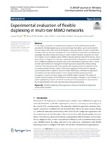Mostrar o rexistro simple do ítem
Experimental Evaluation of Flexible Duplexing in Multi-Tier MIMO Networks
| dc.contributor.author | Fanjul, Jacobo | |
| dc.contributor.author | Fernández, Renzo D. | |
| dc.contributor.author | Ibáñez, Jesús | |
| dc.contributor.author | García-Naya, José A. | |
| dc.contributor.author | Santamaría, Ignacio | |
| dc.date.accessioned | 2020-11-16T16:51:56Z | |
| dc.date.available | 2020-11-16T16:51:56Z | |
| dc.date.issued | 2020-09-24 | |
| dc.identifier.citation | Fanjul, J., Fernández, R.D., Ibáñez, J. et al. Experimental evaluation of flexible duplexing in multi-tier MIMO networks. J Wireless Com Network 2020, 186 (2020). https://doi.org/10.1186/s13638-020-01799-x | es_ES |
| dc.identifier.issn | 1687-1472 | |
| dc.identifier.issn | 1687-1499 | |
| dc.identifier.uri | http://hdl.handle.net/2183/26708 | |
| dc.description.abstract | [Abstract] In this paper, we present an experimental evaluation of the performance benefits provided by flexible duplexing, an access technique that allows uplink and downlink cells to coexist within the same time-frequency resource blocks. In order to replicate a wireless multi-tier network composed of 1 macro-cell and 2 small cells, a measurement campaign has been conducted using an indoor wireless testbed comprised of a total of 6 multiple-input multiple-output (MIMO) software-defined radio (SDR) devices. Since each cell has a single active user, each uplink/downlink configuration can be identified with a different interference channel, over which interference alignment (IA) is used as an inter-cell interference management technique and compared to other existing methods. The obtained results show that flexible duplexing clearly outperforms the conventional time-division duplex (TDD) access approach, where all cells operate synchronized either in uplink or dowlink mode. Additionally, interference alignment consistently provides better results in most of the interference regimes when compared to minimum mean square error (MMSE)-based schemes. The impact of channel estimate quality on the different communication strategies is also studied. It is worth highlighting that the presented over-the-air (OTA) experiments represent the first implementation of IA with real-time precoding and decoding. | es_ES |
| dc.description.sponsorship | Ministerio de Economía, Industria y Competitividad; TEC2016-75067-C4-4-R | es_ES |
| dc.description.sponsorship | Ministerio de Economía, Industria y Competitividad; PID2019-104958RB-C43 | es_ES |
| dc.description.sponsorship | Ministerio de Economía y Competitividad; BES-2014-069786 | es_ES |
| dc.description.sponsorship | Xunta de Galicia; ED431G2019/01 | es_ES |
| dc.description.sponsorship | Ministerio de Economía y Competitividad; TEC2016-75067-C4-1-R | es_ES |
| dc.description.sponsorship | Ministerio de Ciencia, Innovación y Universidades; RED2018-102668-T | es_ES |
| dc.language.iso | eng | es_ES |
| dc.publisher | SpringerOpen | es_ES |
| dc.relation.uri | https://doi.org/10.1186/s13638-020-01799-x | es_ES |
| dc.rights | Atribución 4.0 | es_ES |
| dc.rights.uri | http://creativecommons.org/licenses/by/4.0/ | * |
| dc.subject | Flexible duplexing | es_ES |
| dc.subject | Heterogeneous networks | es_ES |
| dc.subject | Interference alignment | es_ES |
| dc.subject | OFDM | es_ES |
| dc.subject | MIMO testbed | es_ES |
| dc.title | Experimental Evaluation of Flexible Duplexing in Multi-Tier MIMO Networks | es_ES |
| dc.type | info:eu-repo/semantics/article | es_ES |
| dc.rights.access | info:eu-repo/semantics/openAccess | es_ES |
| UDC.journalTitle | Eurasip Journal on Wireless Communications and Networking | es_ES |
| UDC.volume | 2020 | es_ES |
| UDC.issue | 1 | es_ES |
| UDC.startPage | 1 | es_ES |
| UDC.endPage | 16 | es_ES |
| dc.identifier.doi | 10.1186/s13638-020-01799-x |
Ficheiros no ítem
Este ítem aparece na(s) seguinte(s) colección(s)
-
GI-GTEC - Artigos [186]






